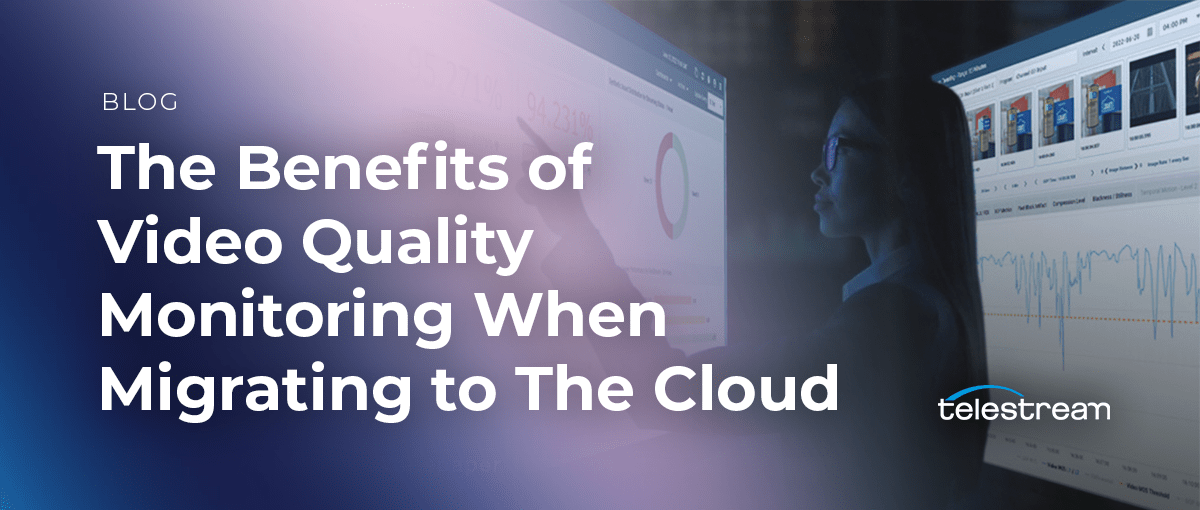By: Joel Daly, VP Product Management at Telestream
A trend among global video service providers is the growing adoption of cloud technology to streamline, optimize, and automate workflows. Whether this is for media content distribution or live video delivery, multiple industry projections from notable firms such as Gartner, Forrester, and IEEE highlight the growing size of cloud end user spending and infrastructure adoption. Service providers migrating to Adaptive Bitrate (ABR) streaming, content owners growing their Direct-to-Consumer (D2C) streaming offerings, and managed service providers are all taking advantage of the cloud. One critical enabler of these migration strategies is a rock-solid Video Quality Monitoring solution.
Why Do You Need A Video Quality Monitoring for A Successful Cloud Migration?
Are you currently evaluating a potential migration to cloud-native media delivery solutions – either as part of a hybrid on-prem strategy or to wholly replace your existing infrastructure? If so, it’s important to fully understand the complexities, challenges, and critical implementation strategies required to truly maximize the potential benefits. Adopting cloud solutions without fully appreciating the nuances and outlining a path to success may lead to suboptimal performance. This ultimately results in a declining experience for your subscribers, who will seek out better options.
One fundamental question that needs to be answered is whose responsibility it is to ensure video quality: is it yours, or the responsibility of the public cloud provider? When using a public cloud service, that video quality responsibility is on you. As such, having a robust, end-to-end solution for monitoring and ensuring optimal video quality from source contribution feeds all the way to delivery is mission critical.
What Challenges Can A Video Quality Monitoring Solution Solve?
Video Quality Monitoring solutions solve three core challenges for media organizations: Lack of Visibility, Lack of Diagnostics, and Lack of Compliance. These three areas can not only help improve the quality of content, metadata, and delivery, but also provide real-time alerts for any issues. This proactively addresses points of failure before they impact end subscribers. What’s more, these solutions also ensure content is keeping up with various regional regulations, such as audio loudness, captioning, and advertising standards. In a world where the global media landscape is dominated by various streaming providers, platforms, and channels, maintaining visibility, diagnostics, and compliance is crucial to your ongoing success.
The Solution: Video Quality Monitoring Management from Source to CDN
Contribution feeds can be make-or-break for a content owner. After all, if upstream sources have issues or are of poor quality, the final content quality will suffer as well. By deploying probes throughout a cloud Kubernetes service, an organization can monitor contribution and post-processed (encoded or transcoded) feeds of content to detect any issues promptly before they have downstream impacts. Monitoring the source feeds is only half the battle, though. Issues can easily arise during the later distribution stages as well. That’s why comprehensive, end-to-end video quality monitoring should encompass source contribution feeds, cloud IP networks, and Content Delivery Networks (CDNs).
Probes can provide this IP network assurance and detect issues like outages, packet loss, and jitter in SRT-wrapped unicast transport streams. For CDN content assurance, these probes can also provide visibility into ABR and OTT content delivery preparation. Ensure bitrate ladders are transcoded correctly, ABR protocols are packaged properly, and any compliance regulations are met. Having this visibility from origin services through caches to monitor CDN performance helps limit buffering issues for subscribers and improves the overall video delivery experience.
How Do I Manage All This Video Quality Monitoring Data?
It may seem daunting to unleash an arsenal of probes at all of these various stages in media distribution. That’s where having a centralized dashboard that aggregates, correlates, and integrates data from these various monitoring points becomes a major value-add. For media organizations that are adopting cloud services into their workflows, a single, intuitive platform to visualize and manage all of these monitoring probes can easily enable cloud adoption. What’s more, they can adopt these solutions into their workflows as it makes sense for them specifically, while maintaining critical control and visibility.
One thing is clear: a video quality monitoring solution can be critically important if a cloud migration is anywhere on your horizon. Learn more about the benefits of video quality monitoring when migrating to the cloud in this whitepaper.

